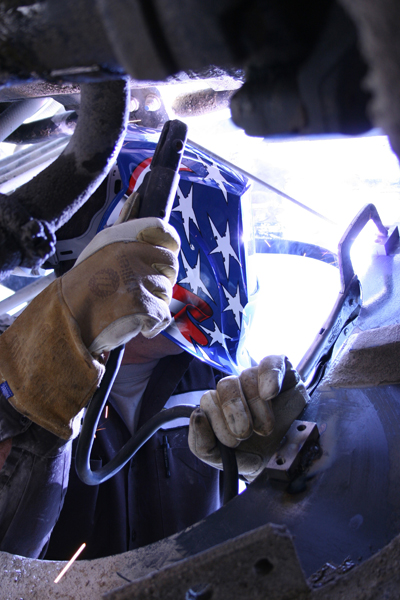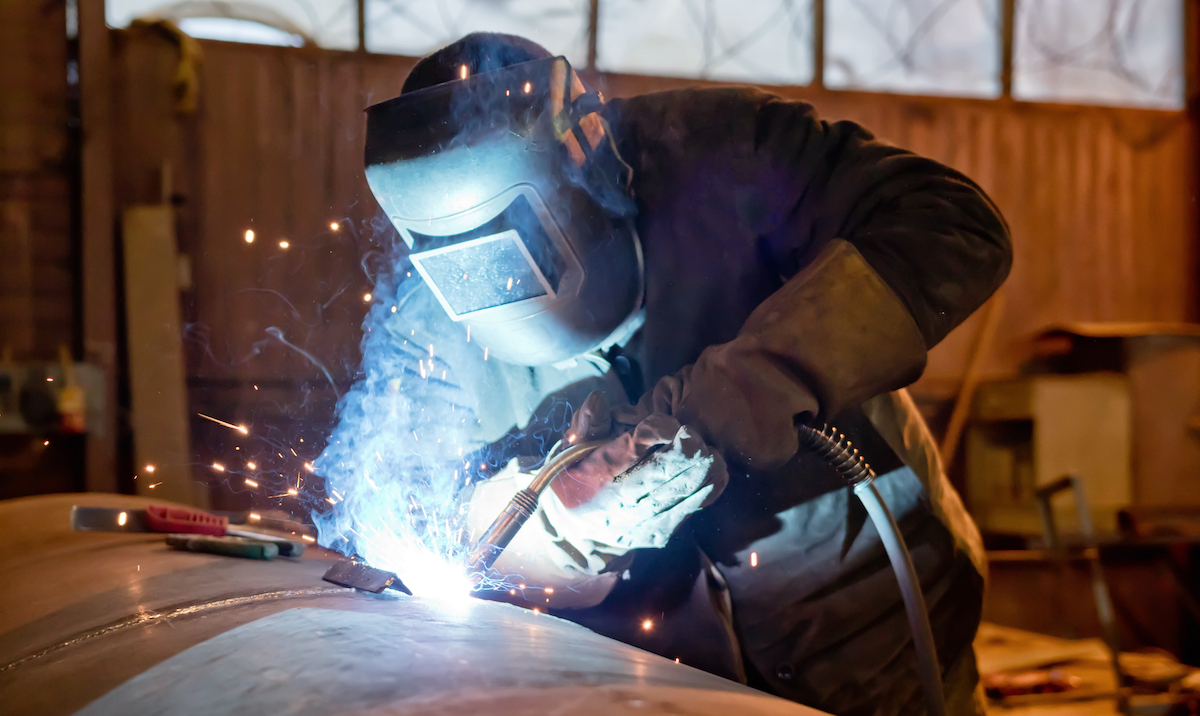Everything about Welding: Trick Insights Into Techniques and Best Practices for Success
Welding includes a variety of strategies, each matched for specific materials and applications. Understanding these methods, such as GMAW, SMAW, and TIG, is essential for accomplishing ideal outcomes. Moreover, the appropriate tools and safety methods can not be forgotten. As preparation and repairing play crucial roles in the welding process, mastering these components can substantially enhance the high quality of the end product. What are the essential variables that assure a successful weld?
Understanding Various Welding Methods
Welding methods encompass a selection of methods, each fit to particular applications and materials. Amongst one of the most common methods are Gas Metal Arc Welding (GMAW), Shielded Steel Arc Welding (SMAW), and Tungsten Inert Gas Welding (TIG) GMAW, additionally referred to as MIG welding, is popular for its speed and versatility, making it excellent for thin products. SMAW, or stick welding, is preferred for its simpleness and performance in exterior environments, especially with thicker steels. TIG welding supplies accuracy and control, making it suitable for complex job and non-ferrous metals (Montana Mobile Welding and Repair Welding). Each strategy has its unique benefits and factors to consider, permitting welders to select the finest technique based on the task's demands, product kind, and preferred end results. Comprehending these strategies is important for effective welding
Essential Welding Tools and Devices
While various welding methods call for particular abilities, the ideal devices and tools are equally important for accomplishing top quality outcomes. Vital welding equipment includes welding machines, which vary relying on the strategy-- such as MIG, TIG, or stick welding. Safety equipment, including gloves, safety helmets, and aprons, guarantees security and convenience during the procedure. On top of that, fixtures and clamps aid secure products in area, making certain accuracy in welds. Consumables like welding poles, wire, and shielding gas are likewise important components that affect the top quality of the weld. Tools such as cutters and mills promote surface preparation and post-weld ending up, adding to a professional end result. Investing in high-quality devices ultimately enhances the performance and efficiency of welding projects.
Safety And Security Practices in Welding
Proper safety practices are crucial in the welding market to shield workers from potential hazards. Welders should wear proper individual protective tools (PPE), including helmets with correct shading, gloves, and flame-resistant clothing. Appropriate air flow is important to decrease direct exposure to unsafe fumes and gases created during the welding procedure. Furthermore, workers should be learnt the correct handling of welding tools to avoid crashes. Fire precaution, such as maintaining flammable products away from the welding location and having fire extinguishers readily offered, are required. Regular assessments of devices and workspaces can aid determine potential dangers before they bring about mishaps. By sticking to these security methods, welders can develop a much safer working setting and decrease risks associated with their trade.
Preparing Materials for Welding
Preparing products for welding is an essential step that considerably influences the high quality and stability of the end product (Belgrade). Correct prep work includes cleansing the surfaces to remove contaminants such as dust, rust, and oil, which can jeopardize the weld. Strategies such as grinding, sanding, or using solvents are generally utilized to achieve a tidy surface. Furthermore, making sure that the materials mesh comfortably is necessary; voids can cause weak welds. It's likewise important to think about the placement and positioning of the components, as this will affect the convenience of welding and the last outcome. Picking the suitable filler material and guaranteeing compatibility with the base steels is important for attaining solid, resilient welds.
Tips for Getting High-Quality Welds
Achieving top quality welds needs focus to information and adherence to best methods throughout the welding process. Proper joint prep work is essential, making certain surfaces are totally free and tidy from pollutants. Selecting the appropriate filler material and welding method based on the base metals is vital for optimal bonding. Preserving regular travel rate and angle while welding can promote and avoid defects uniformity. In addition, regulating warm input is important; too much warm can lead to bending and damaged joints. If necessary, consistently examining the welds during the process permits for instant changes. Lastly, using appropriate post-weld treatments, such as cleaning and stress and anxiety alleviation, can enhance the durability and honesty of the weld, ultimately making sure an effective outcome.
Troubleshooting Common Welding Issues
Welding usually provides difficulties that can influence the high quality and stability of the end product. Usual issues such as porosity, irregular weld beads, and overheating can occur, each needing certain repairing techniques. Comprehending these problems is vital for welders to improve their skills and accomplish perfect results.
Porosity Troubles Described
Porosity can frequently be forgotten, it stays a crucial issue in welding that can endanger the honesty of a completed product. Porosity refers to the presence of little gas pockets within the weld bead, which can lead and damage the joint to premature failing. This issue generally develops from pollutants, moisture, or inappropriate securing gas protection during the welding process. To alleviate porosity, welders should verify that the base materials are clean and dry, utilize proper protecting gases, and keep consistent welding specifications. On a regular basis inspecting the devices and atmosphere can also help identify potential problems before they manifest in the weld. Attending to porosity successfully is necessary for accomplishing solid, resilient welds that satisfy quality criteria.

Inconsistent Weld Beans
Irregular weld beads can significantly impact the top quality and toughness of an ended up item. Different aspects contribute to this concern, including inappropriate travel rate, inaccurate amperage settings, and irregular electrode angles. When get more info the welder moves too rapidly, a grain might show up narrow and do not have penetration, while moving as well gradually can create excessive buildup. Additionally, using the incorrect amperage can lead to either damaging or too much spatter, both of which concession weld honesty. The welder's strategy, such as inconsistent lantern motion, can additionally lead to irregular grain appearance. To alleviate these issues, welders must concentrate on preserving stable, controlled motions and guaranteeing correct equipment settings to attain harmony in their welds. Uniformity is vital to accomplishing trusted and strong welds.
Overheating and Warping Issues
Excessive warmth during the welding procedure can result in considerable overheating and deforming problems, influencing the structural honesty of the workpiece. These issues usually manifest as distortion, which can endanger alignment and fit-up, making further assembly testing. Elements adding to overheating consist of the selection of welding criteria, such as voltage and travel speed, as well as the sort of material being welded. To minimize these problems, welders ought to preserve constant travel rate and ideal heat input while keeping track of the work surface temperature level. Additionally, pre-heating or post-weld warmth therapy can aid minimize stress and anxieties brought on by quick air conditioning - Belgrade. Normal examination and adherence to best practices are important in preventing overheating and ensuring the long life and integrity of bonded structures
Frequently Asked Inquiries
What Are the Job Opportunities in the Welding Industry?
The welding industry provides varied job chances, including placements as welders, instructors, engineers, and examiners. Professionals can function in production, building and construction, aerospace, and auto markets, gaining from solid demand and competitive incomes in various duties.
Just How Can I Boost My Welding Rate Without Sacrificing High Quality?
To boost welding speed without giving up quality, one ought to practice effective methods, maintain devices, enhance setups, and enhance hand-eye sychronisation. Regular training and looking for feedback can likewise considerably add to attaining much faster, top notch welds.
What Accreditations Are Readily Available for Welders?
Many qualifications exist for welders, including those from the American Welding Society (AWS), the National Center for Construction Education And Learning and Research (NCCER), and different industry-specific organizations. These qualifications boost employability and show ability efficiency.
Exactly How Does Welding Impact the Properties of Metals?
Welding influences the homes of steels by modifying their microstructure, which can cause modifications in hardness, ductility, and strength. Heat input and cooling prices during the process substantially affect these product attributes.
Can I Weld Dissimilar Metals With Each Other?
